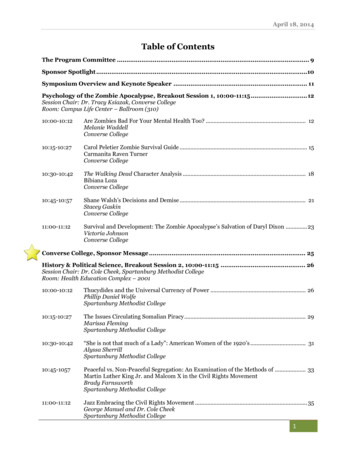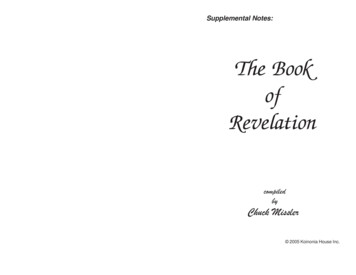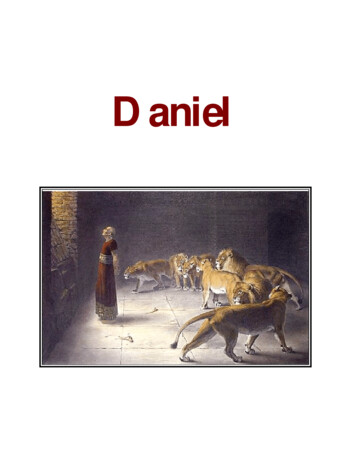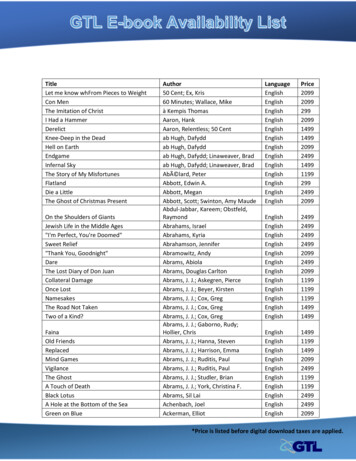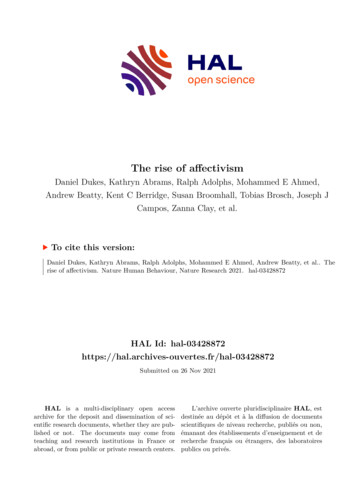
Transcription
The rise of affectivismDaniel Dukes, Kathryn Abrams, Ralph Adolphs, Mohammed E Ahmed,Andrew Beatty, Kent C Berridge, Susan Broomhall, Tobias Brosch, Joseph JCampos, Zanna Clay, et al.To cite this version:Daniel Dukes, Kathryn Abrams, Ralph Adolphs, Mohammed E Ahmed, Andrew Beatty, et al. Therise of affectivism. Nature Human Behaviour, Nature Research 2021. hal-03428872 HAL Id: 3428872Submitted on 26 Nov 2021HAL is a multi-disciplinary open accessarchive for the deposit and dissemination of scientific research documents, whether they are published or not. The documents may come fromteaching and research institutions in France orabroad, or from public or private research centers.L’archive ouverte pluridisciplinaire HAL, estdestinée au dépôt et à la diffusion de documentsscientifiques de niveau recherche, publiés ou non,émanant des établissements d’enseignement et derecherche français ou étrangers, des laboratoirespublics ou privés.
123456789101112131415161718The rise of affectivismAuthor list (alphabetical order of family name, except first and last author)---Daniel Dukes*1,2 (Daniel.Dukes@unifr.ch), Kathryn Abrams3, Ralph Adolphs4, Mohammed E.Ahmed5, Andrew Beatty6, Kent C. Berridge7, Susan Broomhall8, Tobias Brosch1,9, Joseph J.Campos10, Zanna Clay11, Fabrice Clément12, William A. Cunningham13, Antonio Damasio14,Hanna Damasio15, Justin D'Arms16, Jane W. Davidson17, Beatrice de Gelder18,19, JulienDeonna1,20, Ronnie de Sousa21, Paul Ekman22,23, Phoebe C. Ellsworth24, Ernst Fehr25, AgnetaFischer26, Ad Foolen27, Ute Frevert28, Didier Grandjean1,9, Jonathan Gratch29, LeslieGreenberg30, Patricia Greenspan31, James J. Gross32, Eran Halperin33, Arvid Kappas34, DacherKeltner35, Brian Knutson32, David Konstan36, Mariska E. Kret37, Joseph E. LeDoux38, JenniferS. Lerner39, Robert W. Levenson35, George Loewenstein40, Antony S. R. Manstead41, Terry A.Maroney42, Agnes Moors43, Paula Niedenthal44, Brian Parkinson45, Ioannis Pavlidis5,Catherine Pelachaud46, Seth D. Pollak44, Gilles Pourtois47, Birgitt Roettger-Roessler48, JamesA. Russell49, Disa Sauter26, Andrea Scarantino50, Klaus R. Scherer1,51, Peter Stearns52, Jan E.Stets53, Christine Tappolet54, Fabrice Teroni1,20, Jeanne Tsai32, Jonathan Turner53, Carien idSander*1,9,(David.Sander@unige.ch).
er for Affective Sciences, University of Geneva, Switzerland; 2Department ofSpecial Education, University of Fribourg, Switzerland; 3Berkeley School of Law, University ofCalifornia Berkeley, USA; 4Division of Humanities and Social Sciences, California Institute ofTechnology, USA; 5Department of Computer Science, University of Houston, USA;6Department of Anthropology, Brunel University London, UK; 7Department of Psychology,University of Michigan, USA; 8Australian Research Council Centre of Excellence for History ofEmotions, Australian Catholic University, Australia, 9Department of Psychology, University ofGeneva, Switzerland; 10Institute of Human Development, University of California, Berkeley,USA; 11Department of Psychology, Durham University, UK; 12Cognitive Science Centre,University of Neuchâtel, Switzerland; 13Department of Psychology, University of Toronto,Canada; 14Brain and Creativity Institute, University of Southern California, USA; 15DornsifeCognitive Neuroscience Imaging Center, University of Southern California, USA;16Department of Philosophy, Ohio State University, USA; 17Australian Research CouncilCentre of Excellence for History of Emotions, University of Melbourne, Australia;18Department of Cognitive Neuroscience, Maastricht University, The Netherlands;19Department of Computer Science, University College London, UK; 20Department ofPhilosophy, University of Geneva, Switzerland; 21Department of Philosophy, University ofToronto, Canada; 22Department of Psychology, University of California, San Francisco, USA;23Paul Ekman Group, USA; 24University of Michigan, USA; 25Department of Economics,University of Zurich, Switzerland; 26Department of Psychology, University of Amsterdam, TheNetherlands; 27Centre for Language Studies, Radboud University, Nijmegen, TheNetherlands; 28Max Planck Institute for Human Development, Berlin, Germany; 29Institute forCreative Technologies, University of Southern California, USA; 30Department of Psychology,York University, Canada; 31Department of Philosophy, University of Maryland, USA;32Department of Psychology, Stanford University, USA; 33Psychology Department, HebrewUniversity of Jerusalem, Israel; 34Department of Psychology and Methods, Jacobs UniversityBremen, Germany; 35Department of Psychology, University of California, Berkeley, USA;36Department of Classics, New York University, USA; 37Cognitive Psychology Unit, Institute ofPsychology, Leiden University, Netherlands; 38Center for Neural Science, New York University,USA; 39Harvard Kennedy School and Department of Psychology, Harvard University, USA);40Department of Social and Decision Sciences, Carnegie Mellon University, USA; 41School ofPsychology, Cardiff University, Wales, UK; 42Vanderbilt University Law School, VanderbiltUniversity, USA; 43Centre for Social and Cultural Psychology, KU Leuven, Belgium;44Department of Psychology, University of Wisconsin-Madison, USA; 45Department ofExperimental Psychology, University of Oxford, UK; 46CNRS-Institut des Systèmes Intelligentset de Robotique, Sorbonne University, France; 47Department of Experimental, Clinical andHealth Psychology, Ghent University, Belgium; 48Institute of Social and CulturalAnthropology, Freie Universität, Berlin, Germany; 49Psychology Department, Boston College,USA; 50Philosophy Department, Georgia State University, USA; 51Department of Psychology,University of Munich, Germany; 52Department of History, George Mason University, USA;53Department of Sociology, University of California, Riverside, USA; 54Department ofPhilosophy, University of Montreal, Canada; 55School of Psychology and Clinical LanguageSciences, University of Reading, UK; 56School of Humanities, University of Brighton, UK.2
64Standfirst:65Research over the past decades has demonstrated the explanatory power of emotions,66feelings, motivations, moods, and other affective processes when trying to understand and67predict how we think and behave. In this consensus article, we ask: Has the increasingly68recognized impact of affective phenomena ushered in a new era, the era of affectivism?693
70The behavioural and cognitive sciences have faced perennial challenges of71incorporating emotions, feelings, motivations, moods, and other affective processes into72models of human behaviour and the human mind. Such processes have long been73marginalised or ignored, typically on the basis that they were irrational, unmeasurable, or74simply unenlightening. However, it has become increasingly difficult to deny that these75processes are not only linked to our well-being, but also that they shape our behaviour and76drive key cognitive mechanisms such as attention, learning, memory, and decision-making.77Fertile ground for addressing these challenges lies in the writings of the ancient Greeks,78and of eminent scholars such as Descartes, Hume, Darwin, Wundt and James, to name but a79few. The most recent seeds were sown in the 1960s, allowing an unprecedented,80multidisciplinary interest in affective processes to take root around twenty years later.81Research on such processes has positively blossomed since, as growing numbers of dedicated82researchers, departments, research centres, journals and societies contribute to the affective83sciences – a highly integrative endeavour that spans disciplines, methods, and theories. 1-4 By84reaping the fruits of these cumulative advances, we are now able to understand and account85for more of the variability in the available data and formulate more powerful and precise86predictions as a consequence. Indeed, so profound have the repercussions for our shared87models of human behaviour become that we can now ask whether we have moved beyond the88eras of behaviourism and cognitivism, into the era of affectivism.89Characterizing affectivism90One of the leaders of the “cognitive (r)evolution” described how “behavio[u]rism faded91because of its failure to solve basic questions about human thought and action”. 5 Indeed,92although elements of behaviourism continued to influence cognitivist thinking, cognitivism93represented a rejection of some of the central tenets of behaviourism. But the affective94sciences supplement cognitivism rather than supplant it. In fact, if cognitivism is conceived4
95of as an approach in which the inclusion of cognitive processes in models of behaviour, mind96and brain increases the power to explain not only cognitive phenomena but also behaviour,97then affectivism would be the approach in which the inclusion of affective processes in such98models not only explains affective phenomena but, critically, further enhances the power to99explain cognition and behaviour (Figure 1a).100The definition of affective processes, either as a whole or individually, is subject to101debate. For example, questions continue concerning how definitions of emotion should102accommodate the fact that we continuously evaluate events around us and the way in which103our central and peripheral nervous systems allow the emergence of expressions, physiological104arousal and bodily reactions, action tendencies and felt subjective experiences. Nonetheless,105it seems that affective processes are typically understood to relate to the notion of106(dis)pleasure or valence, to not necessarily be consciously felt, and to mobilize the organism107to deal with events that may be important to that organism. In any case, scientific study is108beset by questions of terminology: Persistent difficulties in formally defining ‘cognition’6 did109not prevent the transition from behaviourism to cognitivism, and the fact that there is no110consensus concerning a formal definition of other important constructs such as intelligence,111religion, culture and even life does not preclude fruitful scientific study of them.112Indeed, in spite of these questions of definition of some of its core phenomena, the113affective sciences have already led to a better understanding of how we acquire knowledge of114the objects, concepts and people around us, and how we determine the value of those things.115Importantly, emotions do not just shape how we interpret the world, but also shape which116aspects of the world need our attention and which can safely be ignored: Emotions are not117just about what is, but also about what matters.118Developing affective sciences5
119The recent and transformative influence of the affective sciences on scholarly discourse120about human mind and behaviour is apparent in the evolution of funding (Figure 1b) and121publications (Figure 1c), even in areas related to central cognitive mechanisms - e.g.,122memory, attention, perception, and decision-making (Figures 1d-1g). Particularly in123psychology since the 1980s, the tight relationship between affect, cognition and behaviour124has been revealed in ongoing research topics such as emotional intelligence, emotion125regulation, addiction, decision making and social interaction. But several other disciplines126also began paying increasing attention to affective phenomena around the same time, and the127burgeoning interest continues.128One key example is affective neuroscience. While the term itself emerged only in the1291990s, previous ground-breaking studies of the emotional brain, in particular of the amygdala130and its role in emotional learning, had set the stage for this field to emerge. 7 Studies began to131reveal the brain circuitry responsible for many affective phenomena in animals and humans,132including threat detection and anxiety reactions, homeostatic feelings and motivations, sexual133and affiliative reactions, reward wanting and liking, and addictions. Innovative studies with134brain-damaged patients highlighted the interdependence of cognitive and affective processes,135the distinction between emotions and feelings, and the essential role of emotions in the136decision-making process. Neuroscientific advances also played a key role in popularising137emotion research for the public at large, as the first functional magnetic resonance imaging138pictures in the 1990s seemed to cement the status of human emotion as an objective,139measurable, and scientifically accessible phenomenon. In terms of the origins of our affective140lives, studies of young children began and continue to highlight the critical role of emotion141and motivation in human development,8 and advances in comparative affective science are142providing new insights into the evolutionary and ethological bases of affective processes in143humans and non-human animals.96
144In the clinical domain, long-established classification models of mental health and145illness based largely on lists of behavioural manifestations and cognitive disturbances have146recently been challenged by a new diagnostic system, proposed by the NIMH, which relies147heavily on emotion-related constructs, including arousal, and positive and negative valence148systems.10 Similarly, neuropsychological assessment, intervention and rehabilitation after149brain damage or disease have traditionally focused on cognitive functions (e.g., language,150perception, and memory), but have in recent years begun to take affective domains more151seriously, as has the psychotherapeutic treatment of many mental health problems. These152advances represent key shifts in fundamental conceptions of mental well-being, illustrating153how research on affective processes benefits from and influences advances elsewhere.154A similar illustration can be found in affective computing. Since its launch in the1551990s,11 the development of artificial intelligence and social robotics has led to specific156computational approaches aimed at implementing emotional processes in artificial agents157(socially interactive agents, social robotics, chatbots) and systems. This trend is particularly158apparent in signal processing research that allows more sensitive measuring and monitoring159of affective responses. Affective computing has powerful implications for industry, social160media and education, and, when combined with clinical research, also for health monitoring161and patient care.162There are also key roles for the humanities and the social sciences in the affective163sciences. In recent decades, philosophy has seen emotion, affect, feelings, and related notions164become central explanatory tools, alongside belief and desire, in theories of mind and in165accounts of moral and evaluative thought and behaviour.12 In the field of history, several166research centres dedicated to emotions have been established in the past decade, mapping167how emotions themselves have been conceptualised and expressed differently over time and7
168across cultures, and highlighting the influence of emotions as determinants of historical169action and thought.13170Researchers have also begun to pay more attention to affective processes in general171linguistics, analysing, for example, how emotions are referred to in the languages of the172world via the diverse emotion lexica.14 In terms of cultural comparisons, there are emotion173words that do not seem to have equivalent words in English, such as amae, a Japanese174emotion word which means something like desiring to be loved by or dependent on someone.175In linguistic pragmatics, theories of utterance interpretation now explore not only the176expressive qualities of figurative language (metaphor in particular), but also the direct177manifestation of emotions through linguistic and paralinguistic means, effectively embracing178the very same affective dimension that was formerly disregarded.179Meanwhile, in the social sciences, behavioural economists have developed more180psychologically realistic assumptions about economic agents - homo economicus - by181incorporating affective processes into their theoretical and empirical models of investment182behaviour, medical decision making, bargaining, and issues in political economy such as183voting behaviour. Anthropology, too, has begun to focus on the cultural modelling of human184affective processes, highlighting the intercultural variety of emotion repertoires, while185research in sociology has complemented this approach with a focus on intra-cultural plurality186and the role of emotions in social collectives.15 Indeed, most anthropologists and sociologists187now recognise the significance of emotions in human behaviour, and study emotional188interactions at the micro-level (between individuals or in small groups), the meso-level189(social institutions), and the macro-level (social structures such as class, age or190gender). Emotions are considered fundamental social phenomena, forming the basis for many191kinds of social activities and interactions, and playing an essential role in socialisation8
192processes, such as affective social learning. Thus, just as cognition and behaviour can serve193both social and non-social functions, so too can affect.194The influence of affective sciences is also growing in socially relevant domains,195shaping research and public attention accordingly (Box 1). Other key disciplines in which196emotions and feelings are being taken more seriously as objects of research include the197political sciences, public policy, communication, literature, and the arts.198A relevant and timely question199Scientists typically neglect what they cannot measure in order to reduce noise in their200data and better attend to their object of study: Behaviourism neglected the central role of201cognitive and affective processes; cognitivism neglected the role of affective processes.202While the behavioural and the cognitive sciences remain essential to the study of the mind,203brain and behaviour, given that emotions are often held to involve both cognitive aspects204and behavioural tendencies, an era of affectivism can be seen as a potential205natural successor to206naturally incorporate both perspectives. In this light, perhaps the growing interest in the207affective sciences stems from the maturation of the scientific study of how and why we think208the way we think and do the things we 9But the relevance of the question of whether or not we are in a new era hinges perhaps210not just on an appreciation of historical scientific progress or of the contribution of the211affective sciences, but also on how cognitive processes are defined: If one assumes that all212mental processes – including affective processes – are captured by the word cognitive, then213any blossoming of the affective sciences could be said to be simply part of the further214growth of the cognitive sciences; as such, the question could perhaps seem irrelevant.215Nevertheless, asking it would at the very least constitute a call for our colleagues to consider216advances in the affective sciences in light of their own models and research: considering9
217affective processes in cognitive and behavioural models may well increase the explanatory218and predictive power of such models. Above all, we hope this brief opinion piece might219initiate and stimulate constructive, interdisciplinary, and passionate debate.220The conceptual, methodological and technical advances made within the last few221decades have demonstrated that affective processes are unquestionably enlightening when it222comes to understanding both behaviour and cognition. While it will ultimately be the223responsibility of historians of science to determine whether or not a new era has begun,224given the undeniable impact of affective sciences on our models of brain, mind, and225behaviour, it seems relevant to ask today whether we are now in the era of affectivism.226227228229Total 1992 words (with “standfirst”)23010
1.Davidson, R.J., Scherer, K.R., & Goldsmith, H.H. (Eds.). Handbook of affective sciences. OxfordUniversity Press. (2003).2.Sander, D., & Scherer, K.R. (Eds.). The Oxford companion to emotion and the affective sciences.Oxford University Press. (2009).3.Dalgleish, T., & Power, M.J. (Eds.). Handbook of cognition and emotion. John Wiley & Sons Ltd.(1999).4.Scarantino, A. (Ed.). The Routledge handbook of emotion theory. Routledge. (forthcoming).5.Mandler, G. Origins of the cognitive (r)evolution. J. Hist. Behav. Sci., 38, 4, 339-353.https://doi.org/10.1002/jhbs.10066 (2002), p. 339.6.Bayne, T., et al. What is cognition? Curr. Biol, 29(13), 044 (2019).7.Armony, J., & Vuilleumier, P. (Eds.). The Cambridge handbook of human affective neuroscience.Cambridge University Press. https://doi.org/10.1017/CBO9780511843716 (2013).8.Dukes, D., Samson, A.C, & Walle, E. (Eds.). The Oxford handbook of emotional development. OxfordUniversity Press. (forthcoming).9.Kret, M.E., Massen, J., & Bliss-Moreau, E. (Eds.). Special issue: Building a truly comparative affectivescience. Neuroscience and Biobehavioral Q4N0GFXM7 (2021).10. National Institute of Mental Health. Strategic plan for planning-reports/index.shtml (2008).11. Calvo, R.A., D’Mello, S., Gratch, J., & Kappas, A. (Eds.). The Oxford handbook of affectivecomputing. Oxford University Press. (2015).12. Goldie, P. (Ed.). The Oxford handbook of philosophy of emotion. Oxford University Press. (2009).13. Broomhall. S., Davidson, J., & Lynch, A. (Eds). A cultural history of the emotions (1st ed., Vol. 1-6).Bloomsbury Academic. (2019).14. Pritzker, S.E., Fenigsen, J., & Wilce, J.M. (Eds). The Routledge handbook of language and emotion.Routledge. (2019).15. Stets, J.E., & Turner, J.H. (Eds.). Handbook of the sociology of emotions (Vol. 2). Springer. (2014).26111
262Author contributions263The manuscript was written primarily by the first author D.D. and last author D.S. after264taking into account the inputs and rounds of comments from the other co-authors (K.A., R.A.,265M.E.A., A.B., K.C.B., S.B., T.B., J.J.C., Z.C., F.C., W.A.C., A.D., H.D., J.D’A., J.W.D.,266B.deG., J.D., R.deS., P.E., P.C.E., E.F., A.F., A.Foolen., U.F., D.G., J.G., L.G., P.G., J.J.G.,267E.H., A.K., D.K., B.K., D.Konstan., M.E.K., J.E.LeD., J.S.L., R.W.L., G.L., A.S.R.M.,268T.A.M., A.M., P.N., B.P., I.P., C.P., S.D.P., G.P., B.R.-R., J.A.R., D.Sauter., A.S., K.R.R.,269P.S., J.E.S., C.T., F.T., J.T., J.Turner, C.V.R., P.V., and T.W). I.P. and M.E.A. prepared270Figures 1b-1g. Except for the first author D.D. and the last author D.S., the authorship list is271in alphabetical order.272Competing interests273The authors declare no competing interests.27412
275276Box13
277The growing influence of the affective sciences in socially relevant domains278These examples are taken from core disciplines in the social sciences (including law,279education, environmental research, conflict and reconciliation research).280 Legal scholars are increasingly challenging the incomplete behavioural and281cognitive assumptions inherent in legal theory and practice, carefully282considering the role of affective processes in legal decision making, and283acknowledging how laws and legal rules reflect and create cultural scripts of284how people ought to feel.285 In education research, links between well-being and education are increasingly286uncovered, resulting in changes in policy and the continuing rise in the number287of socio-emotional learning programs.288 In research on climate change mitigation, investigators have begun to focus on289the importance of affective processes for signalling the urgency of the situation290and for motivating collective remedial action, both for private citizens and291governmental organizations.292 In research on violent international conflict, purely ideological or rational293utility-based considerations for group and political actions are now outdated –294they are no longer considered within the limited scope of what is good295(conciliatory) versus what is bad (aggressive) – as research now takes into296account a more diverse scope of distinct emotions and possible consequent297behaviours.29814
299300Figure Caption15
bEmotion research fundingNIMH budget sharea15 %12 %9%6%3%0%cdPublication volume share8%4%0%1988199219962000200420082012Publication volume 016199720002003200620092012201510 612 %8%4%0%1980g1994Emotion content in 'Behaviour' research2016Emotion content in 'Perception' research1991Emotion content in 'Attention' n content in 'Decision making' researchPublication volume sharePublication volume share12 %19841988eEmotion content in 'Memory' research1980fPublication volume 01220162018
gure 1: The scope and increasing impact of the affective sciencesa, asks whether the increasing research focus on affective processes and on their explanatory power means weare now in the era of affectivism. The circular arrows represent how the study of the processes within each boximproves our understanding of the core mechanisms typically investigated in behaviourism, and in the cognitiveand affective sciences, respectively. The bidirectional arrows between the boxes represent the idea that themechanisms described in one box are important to understand those described in the other boxes. b, shows therelative increase of NIMH funding spent on research on emotion since 1985. c, shows the extent to whichpublications with considerable emotion content grew faster than those concerning behaviour without emotioncontent since 1980. The lower panel shows the increasing prominence of publications involving emotion as apercentage of publications in the respective area of inquiry on core cognitive mechanisms such as d, memory, e,attention, f, perception, and g, decision-making.The reference list in the main text focuses on Handbook-type publications to represent the depth and breadth ofthe affective sciences across many academic fields. For a list containing some books and papers that have eitherhelped shape the field in many disciplines in the affective sciences or that have the potential to do so, please seethe suggested reading list in the supplementary material section.16
Supplementary Material Section Dataset address R code directory Figure explanations Supplementary Reading List
A dataset was constructed for the figures and can be found at: https://osf.io/2ktnv/The relevant R code can be found at: https://github.com/UH-CPL/Affectivism-CodeFigure 1bThe relative increase of NIMH funding spent on research on emotion since 1985Figure 1b shows the evolution of NIMH funding on emotion as percentage of the overall NIMH budget on a yearlybasis.MethodologyThe National Institute of Mental Health (NIMH) in the United States is the lead federal funding agency for psychologyand psychiatry. It is one of the 27 agencies that make up the National Institutes of Health (NIH). Accordingly, NIMH,due to its size, prestige, and relevancy to affective and related research, provides an excellent basis for investigatingresearch funding trends. Moreover, NIH is one of the very few research funding agencies world-wide that keepsdetailed public records of its grants since 1985. This information is available through an online portal called NIHRePORTER.From NIH RePORTER, we collected all the NIMH grant data from 1985 to 2018. Then we identified within the NIMHgrants the subgroup of grants related to research on emotion as those that featured either in their title or abstract atleast one of the following keywords: ‘emotion’, ‘emotions’, ‘emote’, ‘emotive’. The figure illustrates the evolution ofresearch funding on emotion as a percentage of overall NIMH funding on a yearly basis. Performing regression onthis normalised time series confirms that funding of research on emotion experienced a significant increase as portionof the overall NIMH budget (Pearson correlation, r 0.260, p 0.001). In fact, it doubled, starting from about 6% ofthe total budget in 1985 and reaching about 12% of the total budget in the late 2010s.Figure 1cThe extent to which publications with considerable emotion content outgrew publications concerningbehaviour without emotion content since 1980Figure 1c shows the evolution of EM publications as percentage of the BBM category since 1980 (see below).MethodologyThe Medical Subject Headings (MeSH) thesaurus is a controlled and hierarchically organised vocabulary producedby the National Library of Medicine. It is used for indexing, cataloguing, and searching of biomedical and healthrelated information. MeSH includes the subject headings appearing in MEDLINE/PubMed, the NLM Catalog, andother NLM databases. (https://www.nlm.nih.gov/mesh/meshhome.html)We used the MeSH category ‘Behavior and Behavior Mechanisms’ (BBM) to acquire through PubMed all the relevantpublications since 1980. In this MeSH category, papers that typically featured considerable affective content falllargely under the branch ‘Emotions’ (EM). Behaviour papers with either non-affective or partly affective content falllargely under the other branches of the BBM category. We consider the EM group the forefront of affectivescholarship.We found in PubMed that between 1980
59 University of Munich, Germany; 52Department of History, George Mason University, USA; 60 53Department of Sociology, University of California, Riverside, USA; . University of Montreal, Canada; 55School of Psychology and Clinical Language 62 Sciences, University of Reading, UK; 56School of Humanities, University of Brighton, UK. 63 . 3
